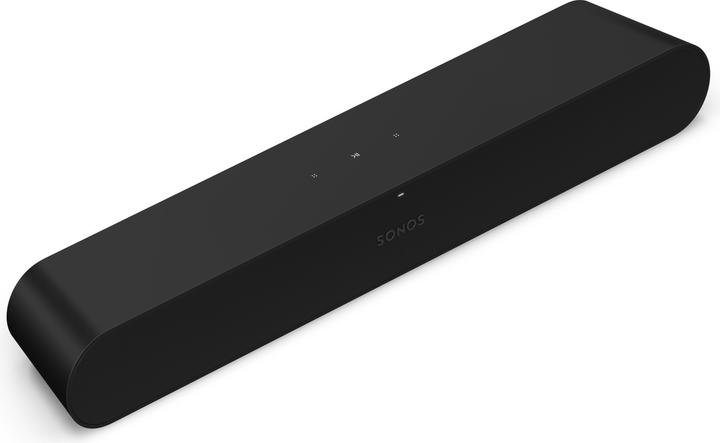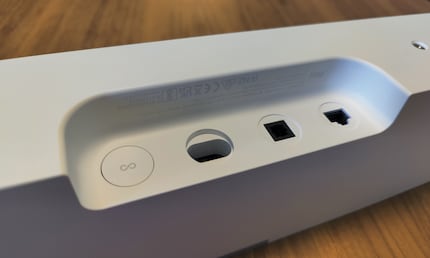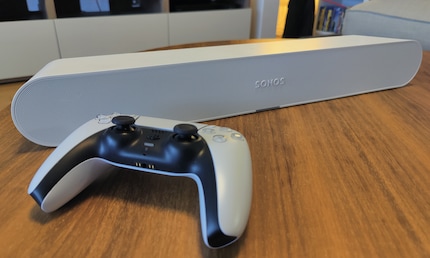

Reviewing the Sonos Ray: the ultimate gateway drug
Who is the Sonos Ray intended for? I find myself asking the same question. After all, it doesn’t do anything that other Sonos soundbars can’t. However, it is much cheaper. And pretty solid too.
A good friend once advised me too «Always start your text with who the product is for,» when writing. Well, with the Sonos Ray, the latest soundbar from the Californian audio specialist, it’s almost easier for me the other way around. I know who it is not made for. The Ray isn’t a soundbar for big living rooms. It’s too small for that. No matter how much digital manipulation is in the processor: for larger spaces, soundbars need a minimum size to fill a room properly with sound. Physics is physics.
So the Ray is for small living rooms? Or bedrooms? Offices?
Yes and no. At least not if you expect audio quality at the very highest level. The soundbar only has one optical Toslink input. It cannot play Dolby Atmos. However, at 329 francs, the Ray is quite affordable by Sonos standards. The Sonos Beam namely costs 469 francs. Sonos Arc, the «flagship soundbar», even hit 949 francs.
So, to get back to the initial question: the Ray is supposedly an «entry-level model» according to its marketing. A «trial run». In other words, an inexpensive product from a manufacturer meant to convince you so strongly that one day you’ll buy more expensive ones for hopefully much more money. Such as an Arc. This works as long as the entry-level model is good despite the lower price. Who would invest more money in the same brand if their first experience was bad?
Exactly. But I can already tell you this much: the Sonos Ray is good. Combine that with the fact that it’s still one of the best multi-room systems on the market.
What’s in the box?
I’ll describe how the Ray sounds in a moment. But first, you’ll need to know what’s in the Ray in the first place. And that’s important contextual information. After all, it’s the mostly elliptical drivers that make air vibrate and thus transport sound from the speaker to your ear. How else are you going to properly classify my flowery descriptions, especially for something as subjectively perceived as sound?
Thus, the Ray is compact and offers little space for drivers. In pure numbers, that means:
- Height: 71 mm
- Width: 559 mm
- Thickness: 95 mm
- Weight: 1.95 kg
These are almost identical measurements to the approximately 40 per cent more expensive Sonos Beam, which I described in my review as a «high-quality soundbar for small (city) apartments, best in bedrooms or hobby rooms». This is also expressed in what can be found under the hood of the Ray:
- Two elliptical midrange drivers reproduce midrange speech frequencies and other midrange frequencies – the Beam has four.
- Two tweeters in the centre reproduce high frequencies. This is important for dialogue. With the Beam, there’s just one tweeter.
- Four Class D digital amplifiers are said to make the sound richer and fill out rooms. In the case of the Beam, there are five digital amplifiers and three additional passive radiators.
To the connections: unlike the Arc and Beam, the Ray doesn’t have an HDMI input, only an optical Toslink input. There’s enough bandwidth to transmit surround sound such as Dolby Digital 5.1 or DTS Digital Surround from the TV or PC to the soundbar without any problems. However, it’s too small for Hi-Res audio formats such as Dolby Atmos or DTS:X. For example, if you select Dolby Atmos, you’ll simply hear Dolby Digital 5.1 instead.

No drama, I think. If you can actually hear the difference between Atmos and 5.1 surround in your living room at home, you can also hear if a bed mite has the sniffles in the flat next door. It would be an insult to the majesty of such audiophiles to try to sell a soundbar to them anyway. Therefore, if you’re flirting with the Ray, forgoing Atmos is a trade-off you can live with.
Watching movies with the Ray: okay
I first tried the Ray in my living room. It’s quite large; about 35 square metres. To hear how the Ray sounds, I watched a scene from «Ford vs Ferrari». The one in which driver Miles pushes his racing car to its limits – and beyond – on the Ford test track.
I had to stop the test after 30 seconds.
To properly fill out my large living room, I had to turn up the Ray to such an extent that the whole soundscape degenerated into an unbearable raucous cacophony. This isn’t a condemnation on Sonos’ part. It’s simply a confirmation that the Ray doesn’t belong in rooms that are too big. New test, then. This time in a bedroom about half the size.
Tested with UHD Blu-Ray, Dolby Atmos, English. All «Ford vs. Ferrari» clips can unfortunately only be watched directly on YouTube. Sorry for the inconvenience.
That’s better. Much better even. The difference between this and my own Sonos Beam, which I usually use here, was barely audible to me. Only when switching back and forth between the two speakers did I feel a little less «rumbling» with the Ray than with the Beam. No wonder: the Beam has more drivers that take care of the mid and low frequencies – aka the bass. Nevertheless, the Ray’s performance is worth listening to.
Around the 1-minute mark: Miles’ brakes just failed. Desperately, he tries – I’m no car expert – to use the transmission to brake by downshifting. The Ray reproduces this deep rumbling crystal clear. Miles turns. Wheels screech. The car is out of control. Some of the barrels filled with water that mark his route are hurled through the air with a «thump». No use. Miles crashes his car into a hill. Bam! The explosion rumbles through my bedroom. For a moment, I think I’m on the test track.
«Okay,» I thought, «not bad.»

But outstanding is a different thing altogether. I know this scene. I’ve listened to it countless times on a Sonos Arc or comparable soundbars. What I’m missing with the Ray is the spatial location of certain objects in the image. Here are some examples: tight at the beginning of the clip, when the roaring engine of Miles Ford’s GT swings from left to right through the frame, the sound swings just as much from left to right in the Arc. Not with the Ray. Sound emerges from the centre of the speaker. The Ray even sounds slightly less wide than the Beam. I noticed that the Beam has a driver and a few more passive radiators than the Ray. We don’t even need to compare it with the Arc.
However, these are the very trade-offs that justify the price difference. It would be unfair of me to expect an audio miracle. And it would be bad for Sonos if I didn’t hear the 700-franc price difference between its entry-level and flagship models.
Listening to music with the Ray: wow, really nice!
I have higher demands regarding music playback. After all, Sonos primarily made a name for itself as one of the best multi-room systems. As a result, even if you use Sonos soundbars primarily for watching TV, they work just as well as speakers for playing music throughout your home. That’s where I expect the Ray to trump the Sonos One, which costs a bit less at 209 francs.
Spoiler alert: the Ray wins out.
I started with Bob Marley. The Legend. No one has brought reggae to a worldwide audience like he has. Partly because his record company always insisted on hi-fi sound quality to make the traditionally rather rough genre more accessible to the masses. «Turn Your Lights Down Low» is a perfect example of this. Listen:
Pay attention to the wondrous spatial recording. Every instrument on the sound stage has its place. Its space. The drums. The acoustic guitar in the background. The Bass. The Keys. Marley’s voice… The Ray reproduces them all without problems, according to the usually high Sonos standard. Bad speakers can’t do that. For me, that’s a quality Sonos feature.
This was also confirmed by the next piece, «Another Day of Sun» from the movie «La La Land». Jazz perfection: the double bass hums along comfortably, a piano plays with harmonies, the drums pulse and swirl in the background while trumpets celebrate the incoming melody. Then around 0:08: there’s the first of numerous «Hmpf» punches I wanted to hear. High-frequency nylon brooms caress the drums. The singer’s voice clearly stands out from the rest of the music. Wonderful.
Finally, at full blast: «B.Y.O.B.» by System of A Down. The song is especially suited for testing as it has numerous passages in which it changes from «very loud» to «very quiet». A challenge for most speakers. The Ray handles it swimmingly, though.
First: the electric guitar. Alone. There’s almost something thoughtful to it. Then, «You!», as the whole band kicks in. The Ray reproduces co-vocalist Daron Malakian blurting out his displeasure to the world at the top of his lungs. Then lead singer Serj Tankian joins the band. The drums are pounding. The Bass as well. My dresser shakes. I headbang.
And suddenly, around 0:52: silence. Serj and the rest of the band sing about society’s ignorance. The track becomes quieter. The Ray takes a step back, displaying good balance. Very good.
Verdict: for anyone wanting to «try out» Sonos
Finally, I try it the other way around. Who is Sonos for? Mainly for users who wanted to get in touch with the brand for a while, but have been put off by the high prices of an Arc or Beam. Sonos’ plan could work out. Once you have the Ray – to serve as a compact soundbar for your bedroom TV, for example – you’ll probably soon buy two Sonos One speakers for real surround sound. It’s not far from there to the nearest Sonos One speakers to get a multi-room system for playing music at home. Soon you’ll want to treat yourself to a proper subwoofer, trust me. And while you’re at it, why not upgrade the soundbar to an Arc and put the Ray in another room – as a speaker?
And so on.
As you can see, it’s about getting your feet wet. To break the 500-franc barrier so you can finally join the Sonos family, if you haven’t already. That’s the Sonos Ray plan. All the more tempting, as Sonos has always focused on modularity: you don’t need to spend 2000 francs all at once to have everything right away. Sonos works the same way. You can approach piece by piece, or speaker by speaker. Until you eventually have at least one Sonos product in every room.
As I said, the inexpensive soundbar as an entry-level drug. Clever marketing.
I write about technology as if it were cinema, and about films as if they were real life. Between bits and blockbusters, I’m after stories that move people, not just generate clicks. And yes – sometimes I listen to film scores louder than I probably should.



